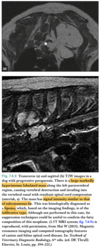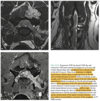Spinal Cord Flashcards
(61 cards)
How are spinal tumors classified?
- Extradural
- Fat suppresion is helpful both in pre- and post-contrast T1Wi
- Most lesions affecting the vertebral bone marrow then to have low signal on T1Wi
- Intradural-extramedullary
- Golf-tee sign: focal dilation of the subarachonoic space along the caudal and cranial margins of the intradular mass, best seen on T2Wi
- Dural tail sign: focal thickening/infiltration of the minienges adjacent to a meningeal mass (e.g. meningioma)
- Tend to enhnce significantly on post-conrtast
- Fat saturation may be useful to determina the extent
- Intramedullary
- Focal swelling of the spinal cord
- Circumferential attenuation of the bright CF signal +/- epidural fat on T2Wi

In dogs, what category of spinal neoplasia is most common?
Extradural followed by intradural-extramedullary
Spinal Cord Neoplasia (dogs)
- Extra-dural spinal cord tumors
.
- Peripheral Nerve Sheath Tumors
- Osteosarcoma
- Synoval myxoma/myxosarcoma
- Plasma cell tumor
- Lymphoma
- Metastatic neoplasia (in particular from porstatic carcinoma or TCC)
- Solitary or disseminated hystiocytic sarcoma
Spinal Cord Neoplasia (dogs)
- Intradural-extramedullary spinal cord tumors
- Nerve Sheath Tumots
- Meningioma
- Nephroblastoma
Spinal Cord Neoplasia (dogs)
- Intramedullary spinal cord tumors
- Ependyoma
- Metastatic neoplasia (in partiacular TCC and hemangiosarcoma)
Less common:
- Asrtocytoma
- Nephroblastoma
- Chondroma
- Oligodendroglioma
In cats what is the most common neoplasia and where is it usually located?
- Lymphoma
- Extradural and mixed extradural-ontramedullary are the most common location
Spinal Cord Neopalsia (cats)
- Extra-dural
- Lymphoma - most common spinal neoplasia overall
- Osteosarcoma - 2nd most common spinal neolasia in cats overall
- Fibrosarcoma
- Undifferentiated sarcoma
- Plasma cell tumors
Spinal Cord Neopalsia (cats)
- Intra-dural
- Meningioma
- Histiocytic neoplasia
Spinal Cord Neopalsia (cats)
- Intra-medullary
- Glial cell
- Primitive neuroendocrine tumors
Are metastatic spinal cord tumors in dogs or cats?
Metastatic vertebral tumors are common in dogs while they are uncommon in cats.
What are some benign spinal cord tumors?
What are imaging characterits of chondrosarcomas on MRI?
The MRI appearance of specific vertebral tumors has been rarely reported. For example, chondrosarcoma tends to form:
- lobulated masses
- often in the dorsal vertebral compartment
- markedly T2 hyperintense with few foci of hypointensity
- iso to hypointense on T1W images with mild to marked peripheral or heterogeneous contrast enhancement
What are Osteochondromas?
- Osteochondroma is a cartilage-capped exostosis with a cortex and medulla that blend smoothly with those of the parent bone.
- The lesion generally arises prior to skeletal maturity from the metaphyseal or juxta-epiphyseal regions of the axial and appendicular skeleton.
- Although they can be clinically silent, signs associated with spinal osteochondromas may include pain and neurologic deficits as a result of spinal cord compression and impingement of adjacent nerves.

What are locations of osteochondromas?
- long bones
- ribs
- vertebrae

Osteochorndromas can undergo malignant transformation into what kind of tumor?
Malignant transformation into osteosarcoma and chondrosarcoma is described with both isolated osteochondroma and multiple cartilaginous exostoses.
What are MRI features of vertebral osteochondrfomas?
- A well-defined mass arising from the surface of the affected vertebra and of similar signal intensity to the adjacent normal bone.
- Presence of a thin cartilaginous cap recognized as:
- a curvilinear T2 hyperintense, T1 iso- to hypointense structure conforming to the surface of the mass.
- Variable degrees of spinal cord compression or foraminal impingement
- There can be variable degrees of mineralization of the cap as the lesion matures, which can also alter the MRI signal intensity (T2W hypointense).

In humans what risk factor has been identified to predict malignant transformation for vertebral osteochondromas?
In people, it was shown that increased thickness of the cartilaginous cap might be associated with malignant transformation, although this has not been demonstrated with dogs and cats.

What are chondromas and what locations are common?
- Chondromas are rare benign tumors characterized by the formation of mature cartilage, more common in flat bones and ribs.
- In the spine, they may originate from the vertebral body, lamina, pedicles, or transverse or spinous processes, or could evolve from hyperplastic immature spinal cartilage or from metaplastic connective tissue in contact with the spine
What are MRI features of synovial myxoma/myxosarcoma?
- A lobulated mass
- Associated with an articular process joint
- Causing distortion/lysis of the adjacent articular processes and possibly widening of the joint space
- The mass typically invades into the adjacent muscles (extends along the fascial planes) and into the vertebral canal, causing variable degrees of spinal cord compression
- Markedly hyperintense on T2W images, with signal intensity similar to that of the CSF
- On T1W images the mass is hypointense and there is moderate to strong enhancement on post-contrast images, which can be diffuse, patchy, or rim-like
- Central non-enhancing areas are common, corresponding to pockets of mucinous substance

What are MRI features of infitrative lipomas?
- Hyperintense on T1W and T2W (turbo or fast spin echo) images with a signal intensity similar to that of normal subcutaneous fat.
- Fat-suppression techniques are useful
- A key feature is the local invasiveness into adjacent muscles and, depending on the case, into the vertebral canal, either through the intervertebral foramina and/or through direct invasion of the vertebrae
- Areas of bony lysis/invasion are typically well marginated
- There is typically no contrast enhancement, although mild enhancement of the muscles infiltrated by the mass may be present, presumably due to associated myositis

What are myelolipomas?
What are common locations of them?
- Myelolipoma is a benign tumor consisting of mature fat interspersed with myeloid and erythroid elements, resembling bone marrow tissue. These lesions are typically asymptomatic; however, large tumors may cause clinical signs as a result of the mass effect. When developing adjacent to the spinal cord, they can cause neurologic deficits and pain.
- They are reported in dogs and cats in the:
- spleen
- adrenal glands
- liver
Their etiology and classification into the neoplasia group are controversial, and some consider them as being ectopic proliferations, hamartomas, or choristomas

What signalment is and location common for epidural myelolipomas?
There are a few reports of myelolipomas in the dog in an epidural location, causing spinal cord compression resulting in proprioceptive ataxia and spinal hyperesthesia.
All the dogs were:
- older male
- sled dogs (a Siberian Husky, an Alaskan Malamute, and a Husky-cross)
And all the lesions were in the:
- thoracolumbar junction area

What are MRI features of epidural myelolipomas?
- Relatively well-marginated lesion in the epidural space, causing spinal cord compression
- Mixed signal intensity with a bulk of T1 hyperintense and T2 hyperintense tissue compared with the spinal cord, interspersed with more hypointense areas, conferring overall a heterogeneous appearance
- On fat suppression pulse sequences, suppression of the hyperintense signal is consistent with fatty components within the mass
- No contrast enhancement

What are peripheral primitive neuroectodermal tumors?
Primitive neuroectodermal tumors are rare embryonal undifferentiated tumors of neural crest origin, which in dogs and cats:
- Most commonly develop in the central nervous system (CNS), in particular the cerebellum where they are referred to as ‘medulloblastomas’, which is mostly seen in young dogs and calves
- The ‘peripheral’ form of the disease develops outside of the CNS; other terminology found in the literature includes ‘neuroblastoma’. It is derived from germinal neuroepithelial cells of the neural crest that are known to differentiate into autonomic ganglia, dorsal root gan- glia, adrenal medulla, skin melanoblasts, and parts of the peripheral nervous system.
























